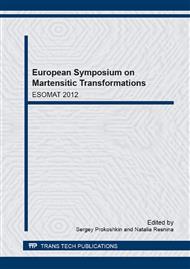[1]
J. Schofer, T. Siminiak, M. Haude, et al., Percutaneous Mitral Annuloplasty for Functional Mitral Regurgitation, Results of the CARILLON Mitral Annuloplasty Device European Union Study, Circulation, v. 120, 2009, p.326–333.
DOI: 10.1161/circulationaha.109.849885
Google Scholar
[2]
V. G. Pushin, R.Z. Valiev, S.D. Prokoshkin, et al., Effect of Equal Channel Angular Pressing and Repeated Rolling on Structure, Phase Transformations and Properties of TiNi Shape Memory Alloys: Materials Science Forum, vol 503-504, 2006, pp.539-544.
DOI: 10.4028/www.scientific.net/msf.503-504.539
Google Scholar
[3]
J. Olbricht , A. Yawny, A.M. Cond´o, F.C. Lovey, G. Eggeler The influence of temperature on the evolution of functional properties during pseudoelastic cycling of ultra fine grained NiTi, Mat. Sci. Eng. A 481-421, 2008, pp.142-145.
DOI: 10.1016/j.msea.2007.01.182
Google Scholar
[4]
A. Yawny, M. Sade, G. Eggeler, Pseudoelastic cycling of ultra-fine-grained NiTi shape-memory wires,. Zeitschrift für Metallkunde 96 (2005) 6, pp.608-618.
DOI: 10.3139/146.101078
Google Scholar
[5]
Shape Memory Materials, Ed. by K. Otsuka and C. M. Wayman, Cambridge University Press, Cambridge, (1998).
Google Scholar
[6]
S.K. Wua, H.C. Lin b, Y.C. Yen a, J.C. Chen Wire drawing conducted in the R-phase of TiNi shape memory alloys. Materials Letters v. 46, 2000, p.175–180.
DOI: 10.1016/s0167-577x(00)00163-4
Google Scholar
[7]
V. E. Gyunter, V. I. Chernyshev, T. L. Chekalkin, Acoustic properties of TiNi-based alloys, Journal of Applied Mechanics and Technical Physics, uly–August 2000, Volume 41, Issue 4, pp.740-744.
DOI: 10.1007/bf02466875
Google Scholar
[8]
S.A. Egorov, M.E. Evard, N.N. Resnina, A.E. Volkov, Influence of stress on the temperature characteristics of martensitic transformation and on strain variation in Ti–Ni shape memory alloys, Materials Science and Engineering, A 462, 2007, p.325.
DOI: 10.1016/j.msea.2006.02.467
Google Scholar
[9]
N. N. Resnina, S. P. Belyaev, A. V. Sibirev, Transformation plasticity and shape memory effects in TiNi alloy after low-temperature treatment, Technical Physics, Volume 56, Issue 4, pp.573-576.
DOI: 10.1134/s1063784211040268
Google Scholar
[10]
Tomohiro Nishiura and Minoru Nishida. Internal Defects of B19' Martensite via R-Phase in Ti-Ni-Fe and Thermally Cycled Ti-Ni Alloys. Materials Transactions, Vol. 50, No. 5, 2009, p.1219 – 1224.
DOI: 10.2320/matertrans.mer2008430
Google Scholar


